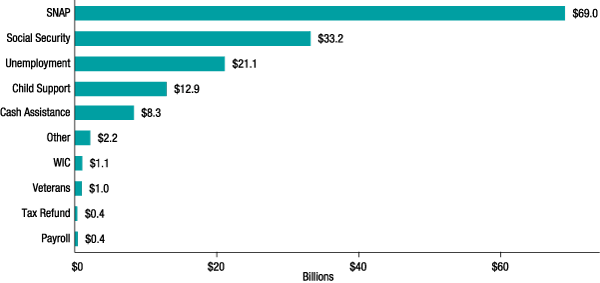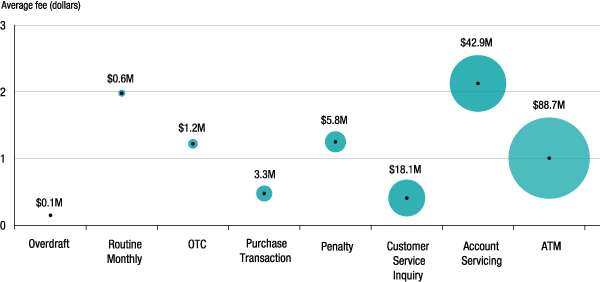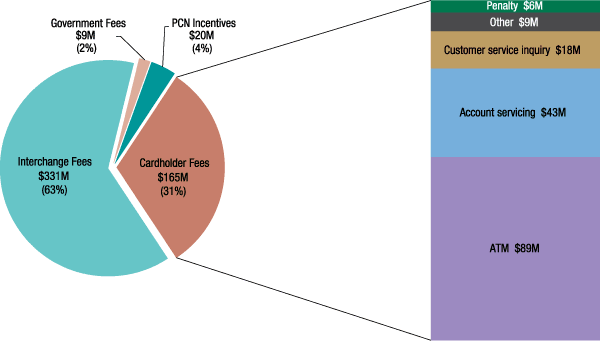Report to the Congress on Government-Administered, General-Use Prepaid Cards
Survey Data and Results
The Board distributed a survey to 19 issuers to collect prevalence-of-use and fee data on federal, state, and local government-administered payment programs that used prepaid cards as a method to disburse funds in calendar year 2015.9 All issuers responded, reporting data for 2,251 programs.10 The Board also collected a limited amount of prevalence-of-use data from the U.S. Treasury, the U.S. Department of Agriculture, and three nonbank payment providers that process EBT transactions.11 The data collected represent programs from all 50 states and the District of Columbia.
As a result of several methodological changes to the data collection process beginning with the data collection for calendar year 2014, many of the figures in this report are not directly comparable with corresponding figures in previous reports.12 Where possible, the Board has provided a limited number of year-over-year comparisons in this report. As the Board collects additional years of data under the revised data collection process, the Board intends to provide more information on general trends in these reports regarding the government-administered prepaid card market.
Prevalence of Use
In this Section:
Calendar Year 2015: Prepaid Card Disbursements
For calendar year 2015, government agencies disbursed $150 billion through prepaid cards across reported programs.13 These prepaid disbursements represent approximately 2.5 percent of total government expenditures in 2015.14
Total funds disbursed through prepaid cards varied widely by program type, as shown in figure 1. State agencies administering SNAP disbursed $69 billion to EBT cards in 2015, accounting for just under half of prepaid funding across all reported programs. The Social Security Administration distributed approximately $33 billion though prepaid cards, representing about one-fifth of all reported funds disbursed through prepaid cards.15 Unemployment insurance, child support, and cash assistance programs largely accounted for the remaining one-third.16 In contrast, WIC, Veterans Affairs, tax refund, and payroll programs each accounted for less than 1 percent of total prepaid disbursements.

Across the largest program types that provide a prepaid card disbursement option, state and local programs tend to have higher rates of prepaid card use than federal programs. Funds disbursed under state SNAP programs, for example, are distributed exclusively through prepaid cards. Similarly, state agencies disbursed a relatively high proportion (65.9 percent) of unemployment insurance payments through prepaid cards.17 In contrast, prepaid card disbursements represent only 3.8 percent of the $879 billion in benefit payments made under federal Social Security programs.18 Similarly, the Department of Veterans Affairs disbursed only 1.2 percent of program funds through prepaid cards.
Year-over-Year Comparisons
Across reported programs, disbursements to prepaid cards increased 1 percent between 2014 and 2015, from $148 billion to $150 billion. As shown in table 1, this increase is driven by a 12 percent rise in prepaid disbursements across reported federal programs. The increase in federal card funding is largely due to a $3 billion increase in prepaid card disbursements under Social Security programs. As table 1 shows, the increase in card funding across federal programs was partially offset by a decrease across state and local programs. This reduction in state and local card funding is, in part, attributable to a $2 billion drop in unemployment insurance benefits disbursed by prepaid card from 2014 to 2015, consistent with continued declines in the number of individuals collecting unemployment insurance benefits. Indeed, according to data obtained from the U.S. Department of Labor, the number of unemployment insurance beneficiaries dropped 11 percent from 2014 to 2015.19 The decline in state and local card funding is also partially attributable to a 1 percent decrease in SNAP disbursements from 2014 to 2015.
| 2014 | 2015 | Change | |
|---|---|---|---|
| Total | $148 | $150 | 1% |
| Federal programs | $31 | $35 | 12% |
| State and local programs | $117 | $115 | -2% |
Fees Collected by Issuers
In this Section:
Issuers receive revenue from two main sources: interchange fees and cardholder fees.20 Less commonly, issuers also receive incentive payments from payment card networks and fees from government offices for providing prepaid services.21 In 2015, issuers reported collecting $331 million in interchange fees, $165 million in cardholder fees, $20 million in payment card network incentive fees, and $9 million in fees assessed to government offices.22 Figure 2 illustrates the various sources of revenue collected by issuers in 2015. Revenue from these sources increased 7 percent across reported programs from 2014 to 2015. This growth in revenue--which is driven by a $21 million increase in interchange fee revenue and a $6 million increase in cardholder fee revenue--is consistent with the increase in card funding across reported programs.23
As shown in table 2, the interchange fees from prepaid card purchase transactions have been relatively stable for the last five years. Across all programs from 2014 to 2015, the average interchange fee per purchase transaction increased by 1 cent, and the average purchase transaction value increased by 34 cents. The average interchange fee as a percent of purchase transaction value remained unchanged at 1.2 percent from 2014 to 2015.
The average interchange fee as a percentage of purchase transaction value remained at 1.1 percent for federal programs in 2015. It increased slightly for state and local programs, from 1.2 percent in 2014 to 1.3 percent in 2015. Like other year-over-year comparisons in this report, the calculations of average purchase transaction value and the average interchange fee per purchase transaction are sensitive to changes in the pool of reported programs, which differs from year to year.24
Transactions made using government prepaid cards are generally exempt from the interchange fee standards of Regulation II. The average interchange fee as a percent of purchase transaction value for government prepaid card transactions is similar to that for all debit card transactions exempt from the interchange fee caps of Regulation II.25
| Average value of purchase transaction 1 (dollars) |
Average interchange fee per purchase transaction 2 (dollars) |
Average interchange fee as percentage of purchase transaction value 3 (percent) |
|||||||||||||
|---|---|---|---|---|---|---|---|---|---|---|---|---|---|---|---|
| 2011 | 2012 | 2013 | 2014 | 2015 | 2011 | 2012 | 2013 | 2014 | 2015 | 2011 | 2012 | 2013 | 2014 | 2015 | |
| Total 4 | 30.94 | 29.99 | 29.94 | 29.16 | 29.50 | 0.33 | 0.34 | 0.36 | 0.34 | 0.35 | 1.1 | 1.1 | 1.2 | 1.2 | 1.2 |
| Federal programs | 36.82 | 38.11 | 44.83 | 38.53 | 38.41 | 0.40 | 0.40 | 0.48 | 0.41 | 0.41 | 1.1 | 1.1 | 1.1 | 1.1 | 1.1 |
| State and local programs | 29.81 | 28.14 | 25.58 | 24.85 | 25.07 | 0.32 | 0.33 | 0.33 | 0.31 | 0.32 | 1.1 | 1.2 | 1.3 | 1.2 | 1.3 |
1. Average value of purchase transaction: Value of settled purchase transactions divided by the number of settled purchase transactions Return to table
2. Average interchange fee per purchase transaction: Total interchange fees divided by the number of settled purchase transactions Return to table
3. Average interchange fee as percentage of purchase transaction value: Total interchange fees divided by the value of settled purchase transactions Return to table
4. For calendar years 2011 and 2012, some program data reported in aggregate could not be allocated between federal and state and local programs. These data, however, are reflected in the total figure. Return to table
Cardholder Fees
The data provided by issuers show that cardholder fee revenue as a percentage of program funds disbursed by prepaid card was unchanged: 0.23 percent between 2014 and 2015.
In addition to negotiating cardholder fee rates, government offices often restrict the number and type of cardholder fees that an issuer can charge. Most government offices require issuers to offer cardholders a certain number of free ATM or over-the-counter (OTC) cash withdrawals and prohibit issuers from charging cardholders certain types of fees, such as monthly maintenance fees.26 Occasionally, issuers provide cardholders with more-favorable terms than those mandated by government offices, such as unlimited in-network ATM and OTC withdrawals.
Figure 3 illustrates the total revenue issuers collected and the average charge per occurrence by cardholder fee type in 2015.27 In 2015, issuers collected $88.7 million on ATM cash withdrawals, accounting for 54 percent of revenue issuers received from cardholder fees. The average fee charged by an issuer for an ATM cash withdrawal was $1.01 per transaction. Account servicing fees represent roughly 26 percent of total cardholder fee revenue, while customer service inquiry, penalty, purchase transaction, and OTC fees largely account for the remaining 20 percent of total cardholder fee revenue. Account servicing fees are the highest type of cardholder fee, at an average of $2.13 per occurrence. Overdraft fees continued to be the smallest source of cardholder fee revenue, accounting for less than 0.1 percent of total cardholder fee revenue in 2015.28

Note: Size of bubble represents total revenue from fee.
Position of black dot on vertical-axis represents average fee when charged.
Although figures 2 and 3 illustrate the distribution of cardholder fee revenue on an aggregate level, this distribution is not representative of any particular program. Government offices and issuers negotiate a cardholder fee schedule for each program. Furthermore, the proportion of transactions resulting in the assessment of a cardholder fee depends heavily on the type of program. As a result, there is significant heterogeneity in cardholder fees across programs that use prepaid cards to disburse funds.
Fees Paid by Issuers
Issuers pay fees to third parties when a cardholder withdraws cash from an out-of-network ATM or bank.29 In 2015, issuers reported paying approximately $59 million in fees to third parties for ATM withdrawals and $26 million in fees to third parties for OTC cash withdrawals.30
References
9. "Government-Administered, General-Use Prepaid Card Survey--Issuer Survey," FR 3063a, OMB No. 7100-0343, Board, www.federalreserve.gov/paymentsystems/files/FR3063a_government_issuer_survey_2015.pdf. The FR 3063a survey is conducted annually to collect information for this report. The Board identified issuers to survey by consulting with relevant payment card networks. The Board reviewed the data submitted by survey respondents for completeness, consistency, and anomalous response. Where possible, the Board resolved identified issues by following up with respondents and by replacing problematic data elements with imputed values. In computing a given summary statistic for this report, the Board excluded responses with unresolved issues that affected the calculation's inputs. Although the Board makes a comprehensive effort to identify and resolve issues in the reported data, some issues may not have been identified by the time this report was published. Return to text
10. Issuers self-reported the number of programs included in their responses. Some issuers were unable to distinguish between multiple government-administered payment programs that disburse funds on the same card. The number of programs, therefore, represents a lower-bound approximation. Return to text
11. Program counts were not available from these organizations. Return to text
12. The Board made several material changes to the data collection process, beginning with the calendar year 2014 data collection. For example, the Board discontinued the FR 3063b survey of government agencies (government survey) and instead relied on the data collected from the FR 3063a survey of issuers (issuer survey) and publicly available government expenditure data to calculate prevalence-of-use metrics. In addition, the Board significantly revised and simplified the reporting process for the issuer survey. For previous Board reports to the Congress on government-administered, general-use prepaid cards, see "Payment Research," Board, last modified September 3, 2015, www.federalreserve.gov/paymentsystems/payres_papers.htm. Return to text
13. Funds disbursed onto prepaid cards but ultimately returned to government agencies are excluded from this figure. The value of funds returned to government agencies is de minimis (equal to 0.1 percent of gross funds disbursed through prepaid cards in 2015). Return to text
14. "Table 3.1. Government Current Receipts and Expenditures," U.S. Department of Commerce, Bureau of Economic Analysis, last modified May 27, 2016, www.bea.gov/national/pdf/SNTables.pdf. Total government expenditures include expenditures of federal, state, and local governments. Return to text
15. For the purposes of this report, Social Security programs include Old-Age, Survivors, and Disability Insurance and Supplemental Security Income. Return to text
16. Cash assistance includes TANF, Low Income Home Energy Assistance Program, child care, refugee assistance, and general assistance programs. Return to text
17. "Monthly Program and Financial Data," U.S. Department of Labor (DOL), accessed June 2016, www.ows.doleta.gov/unemploy/claimssum.asp. Disbursements for state unemployment insurance totaled $32.0 billion in 2015. Return to text
18. Information about total payments made under Social Security programs was provided by the U.S. Treasury. Return to text
19. "Unemployment Insurance Data," DOL, last modified June 10, 2016, www.oui.doleta.gov/unemploy/DataDashboard.asp. For this comparison, the number of beneficiaries includes beneficiaries of regular state unemployment compensation as well as beneficiaries of extended benefit programs. Return to text
20. 12 CFR 235.2(j). An interchange fee is any fee established, charged, or received by a payment card network and paid by a merchant or a merchant acquirer for the purpose of compensating an issuer for its involvement in an electronic debit transaction. Merchant acquirers typically pass the cost of these fees on to merchants. Interchange fees, in effect, are a cost to merchants and a source of revenue to issuers. Return to text
21. Incentive payments are payments received by an issuer from a payment card network with respect to debit card transactions or debit-card-related activity. Issuer incentives may be based on reaching specified volume levels, promoting the network's brand through marketing activities, converting the issuer's debit card base to a different signature network, or undertaking other activities. Incentive payments do not include payments from a network to an issuer for traditional banking services the issuer provides to the network (for example, transaction account services to the network). Issuers may also receive revenue from interest on program funds held in pooled bank accounts before the beneficiaries use them; however, the Board does not gather data on this source of revenue. Return to text
22. Consistent with previous reports, the Board calculated all revenue figures in this report using data collected through the issuer survey on the population of network-branded government-administered, general-use prepaid cards (excluding EBT cards). For EBT card programs, states generally pay an issuer or processor based on the number of beneficiaries enrolled in a program per month, in part because there are no interchange fees associated with these card programs. Certain cardholder fees, such as a fee for card replacement, may also apply to EBT programs. Return to text
23. An increase in card funding generally leads to higher transaction volume, which, in turn, generates additional interchange and cardholder fee revenue for issuers. Return to text
24. The pool of reported programs changes over time because government agencies may add or eliminate programs and may alter disbursement methods for existing programs. Return to text
25. See "Regulation II (Debit Card Interchange Fees and Routing), Average Debit Card Interchange Fee by Payment Card Network," Board, www.federalreserve.gov/paymentsystems/regii-average-interchange-fee.htm. Network-branded government-administered, general-use prepaid card transactions constituted approximately 4 percent of all exempt transactions in 2015. Return to text
26. For definitions of the various cardholder fees mentioned in this report, see "Government-Administered, General-Use Prepaid Card Survey--Issuer Survey," FR 3063a, OMB No. 7100-0343, pp. 31-33, Board, www.federalreserve.gov/paymentsystems/files/FR3063a_government_issuer_survey_2015.pdf. Return to text
27. The Board excluded transactions for which no fee was assessed from the average fee calculations. Return to text
28. As of July 21, 2012, prepaid cards that may incur overdraft fees are ineligible for the exemption from the interchange fee standards of Regulation II. It appears that, rather than lose the exemption, issuers have largely abandoned overdraft fees. 15 USC 1693o-2(a)(7)(B). Pursuant to section 920 (a)(7)(B) of the EFTA, the exemption from the interchange fee standards of Regulation II does not apply if, on or after July 21, 2012, the issuer may charge the cardholder an overdraft fee with respect to the card, or an ATM fee for the first withdrawal per calendar month from an ATM that is part of the issuer's network. Return to text
29. Issuers pay fees to ATM operators for each ATM cash withdrawal to compensate the operator for the costs of deploying and maintaining the ATMs and of providing cash services to the issuers' cardholders. Issuers pay fees to banks for each OTC cash withdrawal to compensate the bank for the costs of staffing the teller window and providing cash services to the issuers' cardholders. In addition to ATM and OTC fees, issuers pay fees to payment card networks (such as switch, license, and connectivity fees). The Board does not survey issuers of government-administered prepaid cards regarding network fees. Across all debit cards, issuers paid networks approximately 4.2 cents per transaction in 2015. For more information, see "Regulation II (Debit Card Interchange Fees and Routing), Reports and Data Collections," Board, www.federalreserve.gov/paymentsystems/regii-data-collections.htm. Return to text
30. On average, issuers paid approximately 59 cents per ATM cash withdrawal and $2.45 per OTC cash withdrawal in 2015. Because of limited data, the Board approximated the number of ATM and OTC withdrawals resulting in a fee. Therefore, the calculations of average ATM and OTC fees paid by issuers are estimates. New information provided by survey respondents this year indicates that the value of fees paid by issuers to third parties in calendar year 2014 was underestimated in last year's report. The 2014 values in that report, therefore, should be considered lower-bound approximations. Return to text

